Human Orbital Spaceflights
![]()
International Flight No. 187STS-78Columbia (20)78th Space Shuttle missionUSA |
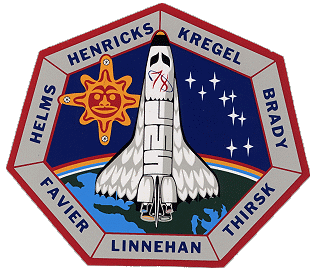 |
 |
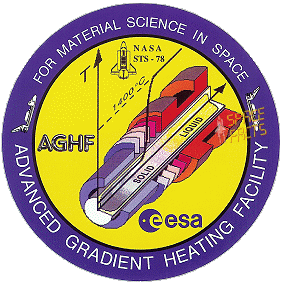 |
||
![]()
Launch, orbit and landing data
walkout photo |
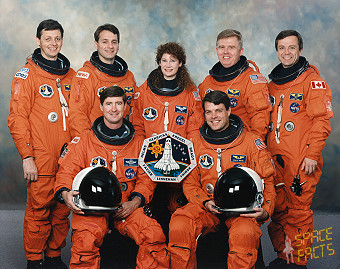 |
||||||||||||||||||||||||||||
alternative crew photo |
|||||||||||||||||||||||||||||
alternative crew photo |
Crew
| No. | Surname | Given names | Position | Flight No. | Duration | Orbits | |
| 1 | Henricks | Terence Thomas "Tom" | CDR | 4 | 16d 21h 47m 34s | 271 | |
| 2 | Kregel | Kevin Richard | PLT, IV-1 | 2 | 16d 21h 47m 34s | 271 | |
| 3 | Linnehan | Richard Michael | MS-1, EV-2 | 1 | 16d 21h 47m 34s | 271 | |
| 4 | Helms | Susan Jane | MS-2, PLC, FE, EV-1 | 3 | 16d 21h 47m 34s | 271 | |
| 5 | Brady | Charles Eldon, Jr. | MS-3 | 1 | 16d 21h 47m 34s | 271 | |
| 6 | Favier | Jean-Jacques Henri | PS-1 | 1 | 16d 21h 47m 34s | 271 | |
| 7 | Thirsk | Robert Brent | PS-2 | 1 | 16d 21h 47m 34s | 271 |
Crew seating arrangement
|
 |
|
||||||||||||||||||||||||||||||||
Backup Crew
|
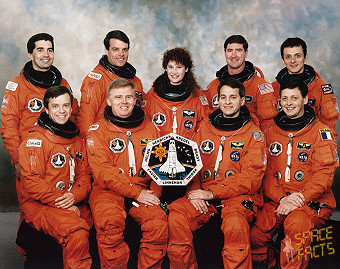 |
|||||||||||||||
alternative crew photo |
Hardware
| Orbiter : | OV-102 (20.) |
| SSME (1 / 2 / 3): | 2041-1 (1.) / 2039 (2.) / 2036 (3.) |
| SRB: | BI-081 / RSRM 55 |
| ET: | ET-79 (LWT-72) |
| OMS Pod: | Left Pod 05 (9.) / Right Pod 01 (24.) |
| FWD RCS Pod: | FRC 2 (20.) |
| RMS: | - |
| EMU: | EMU No. 3015 (PLSS No. 1015) / EMU No. 3010 (PLSS No. 1010) |
Flight
|
Launch from Cape Canaveral (KSC) and
landing on Cape Canaveral (KSC), Runway 33. The flight involved the Life and Microgravity Sciences (LMS) payload being carried in the pressurized Spacelab module in Columbia's cargo bay and focused on two main areas. The LMS life science studies probed the responses of living organisms to the low-gravity environment and highlight musculoskeletal physiology. LMS microgravity experiments focused on understanding the subtle influences at work during processing of various samples, such as alloy materials, when gravity's effect is greatly reduced. On Earth, gravity distorts scientific results. Materials processed on orbit reveal underlying secrets masked or distorted in ground-based laboratories. Likewise, free from gravity, the human body undergoes changes that can affect astronaut performance. While LMS life sciences information will help prepare crews for longer duration missions, the causes of, and cures for, similar ailments experienced on Earth may be found. The crew entered the 40 foot (13 m) long pressurized Spacelab module to commence over 40 science experiments to take place during the mission. Not only did these experiments make use of the module’s laboratory, but also employed lockers in the middeck section of the Columbia Orbiter herself. Thirteen of the experiments were dedicated to studying the effects of microgravity on the human body, whilst another six studied the behavior of fluids and metals in the almost weightless environment and the production of metallic alloys and protein crystals. The crew also carried out the first ever comprehensive study of sleep patterns in microgravity, research into bone & muscle loss in space, and inflight fixes to problem hardware on the Bubble, Drop and Particle Unit (BDPU), designed to study fluid physics, experiments in the areas of life science and materials science. Experiments for planned long duration missions onboard the ISS were performed. LMS life science studies were divided into two fields - human physiology and space biology. The five areas of human physiology were musculoskeletal, metabolic, pulmonary, human behavior and performance, and neuroscience. Three space biology experiments were studied growth of pine saplings, development of fish embryos, and bone changes in laboratory rats. Four major space agencies sponsored the human physiology experiments that made up the Johnson Space Center Human Life Sciences Project. They were NASA, the European Space Agency (ESA), the French Space Agency (CNES) and the Canadian Space Agency (CSA). Since each complementary experiment studied a different body area, a well-rounded data base was generated to help researchers understand how the body changes in low gravity so they can develop effective countermeasures. Musculoskeletal Investigations - Muscles that Control Movement: Although the skeletal muscles continue to control and move the body when on orbit, astronauts experience muscle wasting similar to the aging process or inactivity. This muscle loss seems to be short-lived and reversible, but long-duration flight effects are unknown. During crew sessions on an exercise ergometer, breathing and heart-rate measurements were made. Right calf muscle performance was evaluated using the Torque Velocity Dynamometer workstation. Measurements made several times during the mission were compared to data collected before and after flight. Muscle fiber samples were taken 45 days before launch and soon after landing for laboratory analysis. Metabolic Investigations - Regulatory Functions: The dynamic human skeleton continually makes and removes bone from the body. In space, reduced gravitational loads may induce the skeleton to discard calcium; bone loss begins shortly after reaching orbit. While seeking countermeasures, researchers may discover treatments for the debilitating disease osteoporosis. Crew members took a nonradioactive calcium isotope at each meal, from 10 days before the mission to 7 days after. By tracing the isotope in relation to food and drink intake, scientists distinguished calcium intake from that shed through waste to determine the amount used by bones. Pulmonary Investigation - Lung Function: Previous flight studies indicate gravity is not the only factor in perfusion/ventilation gas flow and blood flow differences between the top and bottom of the lung. These changes were measured before and during exercise to determine the mechanisms of ventilatory changes. Using astronaut lung function experiment equipment, the crew member inhaled either cabin air or a test gas. Exhaled gases were monitored continuously. A wired vest gauged rib cage and chest motion to learn how microgravity affects the musculoskeletal aspects of breathing during heavy exercise, deep breathing and rest periods. Data also was collected before and after flight and several weeks following the mission. Human Behavior and Performance Investigations - Sleep, Schedule and Skills: This was the first simultaneous study of sleep, 24-hour circadian rhythms and task performance in microgravity. While cues such as sunrise and sunset help "set" our biological clocks, in low-Earth orbit light and dark periods alternative every 45 minutes as the Shuttle circles the globe. Periodically during the mission, crew members had to wear a belt-pack connected to a temperature sensor and another to a sleep cap with electrodes that measured brain waves, eye movements and muscle tone while sleeping. Mood and performance tests were performed. Urine was collected to help track normal daily rhythms. An identical ground study was conducted after the mission. Neuroscience Investigations - Adapting to Space: Space adaptation syndrome, a common symptom of adjusting to microgravity, produces motion sickness. Although symptoms disappear in a few days, this syndrome is uncomfortable and affects performance. The flight crew at times had to wear sensor packages that measured eye, head and torso movements during normal on-orbit activities early, midway and late into the flight. This information was compared to data obtained before flight to help researchers recommend ways to move in order to reduce discomfort and improve performance. The three space biology experiments and associated science support were managed by Ames Research Center, Mountain View, CA; Kennedy Space Center, FL; and Walter Reed Army Institute of Research, Washington, DC. Lignin Formation and the Effects of Microgravity: A New Approach: Trees form inferior "reaction" wood when they right themselves from a bend. Lumber and paper industries want to know how to control and prevent this process. Biologists wanted study how pine seedlings respond on a cellular level to bending stress in microgravity to study the mechanism of this tree growth. Development of the Fish Medaka in Microgravity: During embryonic development, a single cell divides into many cells, which become organs and function as a living system. Medaka fish embryos should help researchers determine gravity's role in normal development. This knowledge will contribute to theories about development conditions for other vertebrates, such as humans. Role of Corticosteroids in Bone Loss During Space Flight: Corticosteroid hormones are produced by the adrenal gland in response to stress. Excess corticosteroids may contribute to bone changes during space flight, as well as other stressful periods. To develop effective countermeasures, scientists need to determine how microgravity affects bone mass, levels of bone formation and resorption, and bone cell activity. STS-78 microgravity science experiments involved basic fluid physics investigations, advanced semiconductor and metal alloy materials processing, and medical research in protein crystal growth. These were conducted primarily through "telescience", a mode of operation where scientists on the ground remotely command experiments in orbit. Crew involvement was complementary - they had to check out and activate equipment once on orbit and install and remove samples. Fluid physics research in the Bubble, Drop and Particle Unit (BDPU) may lead to advances in materials processed on Earth. To enable this type of progress, scientists need a better understanding of fluid processes that play a role in the production of most materials. On Earth, gravity-induced flows, such as convection, often hide more subtle effects. By contrast, in space-based investigations these more subtle fluid processes often dominate movements in fluids. Using the BDPU, the fluid physics investigations should help uncover processes involving either gas bubbles, liquid drops or liquid layers. Products that should benefit from this research include new high-strength metals and temperature-resistant glasses and ceramics for building everything from better electric power plants to future spacecraft. The BDPU was developed by the European Space Agency. Commands sent from the ground injected bubbles or drops into liquid-filled test cells and then subject the cells to specific changes in temperature. Cameras and sensors observed and recorded temperature, pressure and position of the bubbles or drops. The test cells were used to study how bubbles and drops react in liquids with varying temperatures and concentrations, how they affect solidification, how convection affects liquid layers at different temperatures, and how evaporation and condensation affect bubble creation and growth, and how liquid columns react to electrical fields. Advanced Gradient Heating Facility - Materials Processing: Scientists perform materials processing experiments to understand the conditions at which freezing materials change from solidifying with a flat boundary or transition surface (edge) to solidifying with cellular and dendritic (tree like) transition shapes. They also want to determine the influences that affect these changes, to enable achieving the exact structure desired in a material. Using the Advanced Gradient Heating Facility (AGHF) furnace for solidifying alloys and crystals, scientists could study these changes in ways that are not possible on Earth, improving our understanding of materials processing. The AGHF used pulses of electrical current to mark the internal shape of a material's solidifying edge, a process called Peltier pulse marking. By examining cross-sections of these crystals, scientists can locate these marks and determine the precise growth rate for each portion of a sample, as well as the shape of the crystal edge at the time of the pulse. The six materials processing experiments in this facility increased knowledge of the physical processes involved in solidification, improving materials processing on Earth and in space. The Advanced Protein Crystallization Facility (APCF) was the first facility ever designed to use three methods of protein crystal growth. By examining the molecular structure of proteins, medical researchers should gain insight into these basic building blocks of life. The APCF experiments could improve food production, as well as lead to innovative new drugs to combat disease. Protein crystals, like snowflakes, are structured in a regular pattern. Earth-grown crystals show the effects of a growth process analogous to a sports stadium filling with fans who all have reserved seats. Each molecule of a crystal also has its own "reserved" seat. Once the gates open, people flock to their seats and in the confusion often sit in someone else's place. On Earth, gravity-driven convection keeps the molecules crowded around the "seats" as they attempt to order themselves. Unfortunately, many molecules take the wrong place or collapse. Such flaws are greatly reduced in microgravity. The Space Acceleration Measurement System (SAMS) measured high-frequency accelerations such as Shuttle thruster firings. Several materials and fluid science experiments are particularly sensitive to accelerations in the frequency ranges that SAMS will record. As the Shuttle travels at 17,500 miles per hour, it slows down slightly due to atmospheric friction. Also, friction varies as atmosphere density changes from day to night and with altitude. The Orbital Acceleration Research Experiment (OARE) made extremely accurate measurements of low-frequency changes in accelerations and vibrations experienced during on-orbit operations. The Microgravity Measurement Assembly (MMA) facility determined both high- and low-frequency spacecraft disturbances. This onboard system provided a network of sensors at selected locations inside the Spacelab module and integrates the output of experiment-dedicated and remote sensors into an unified data set. The STS-78 crew also took on the role of teachers as they educated students in the United States and other countries about their mission objectives. Using the Shuttle Amateur Radio Experiment-II, which was carried aboard the Shuttle on a regular basis, crewmembers talked with students around the world about what it is like to live and work in space. The mission also featured a test of a procedure that was later used during the second Hubble Space Telescope servicing mission to raise the telescope’s altitude without damaging the satellite’s solar arrays. During the test, Columbia’s vernier Reaction Control System jets were gently pulsed to boost the Shuttle's altitude without jarring any of the mission payloads. The test was successful, and was later employed by Discovery during STS-82, and was used multiple times to boost the orbit of the ISS during visits by Shuttles. It was the longest shuttle flight to date. |
Photos / Graphics
 |
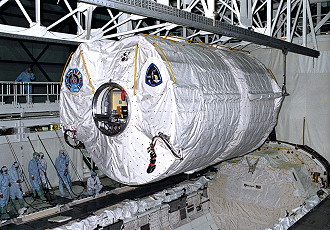 |
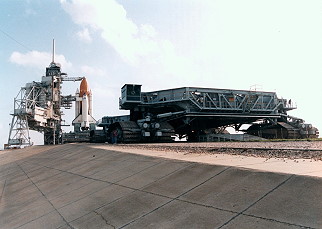 |
 |
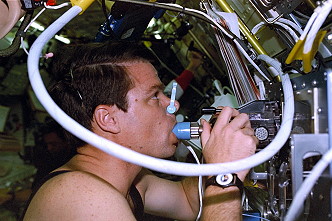 |
 |
 |
 |
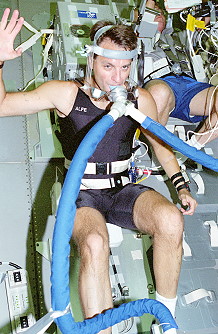 |
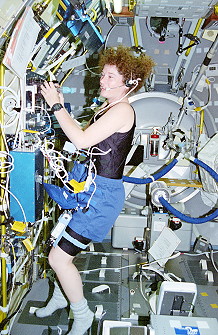 |
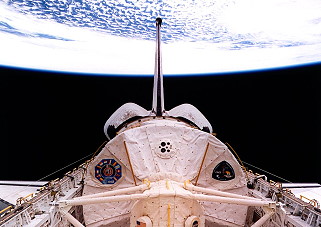 |
 |
| © |  |
Last update on September 10, 2020.  |
 |